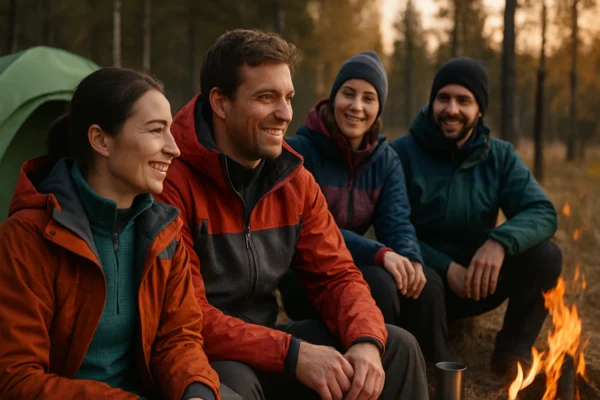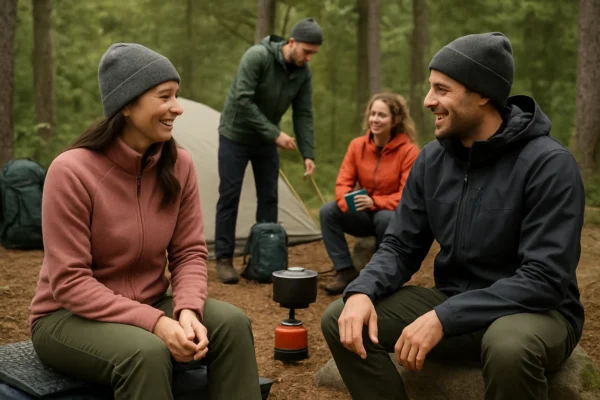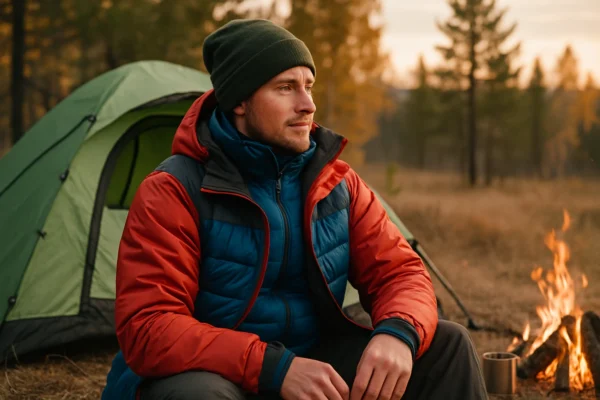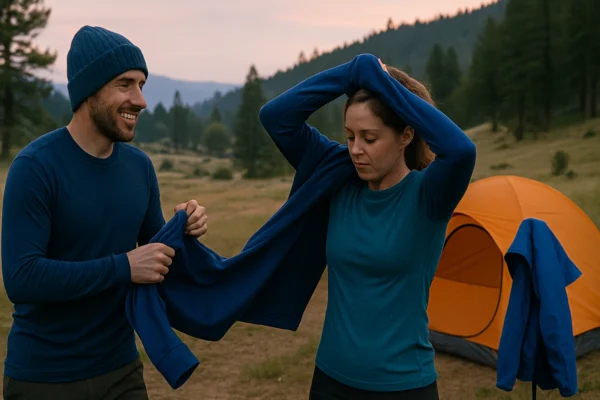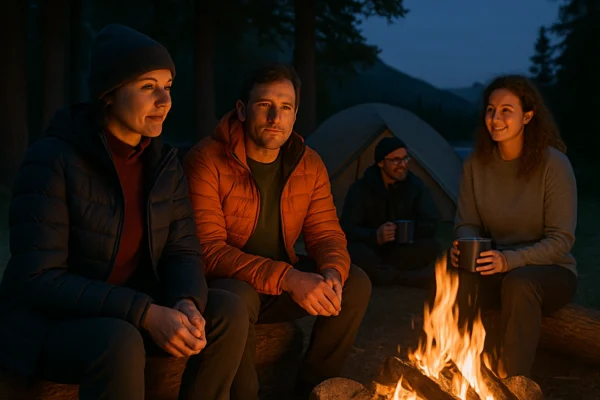Master the Mid-Layer: Sweatshirt Layering Strategies for Campers
When you’re out in the wild, staying comfortable isn’t just a matter of packing enough clothes, it’s about packing the right clothes. Weather conditions can change fast, and your activity levels will vary throughout the day, from hiking steep trails to sitting still at camp. That’s why mastering the art of layering is key to any successful camping trip.
A good layering system helps you regulate body heat, manage moisture, and adapt easily as temperatures shift. In this setup, the mid-layer plays a critical role and that’s where a sweatshirt, especially one made of fleece or technical fabric, really shines. It’s warm, breathable, and versatile, perfect for keeping you cozy without overheating when you’re on the move.
Layering Basics in the Outdoors
If you’ve ever felt too cold during a morning hike but overheated by noon, you’re not alone, that’s exactly why layering matters. It’s not just about wearing more clothes; it’s about wearing the right clothes in the right order. Outdoor experts rely on the Three-Layer System, a tried-and-true approach that helps your body stay dry, warm, and protected in changing conditions.
Base Layer: Moisture Management
This is the layer closest to your skin, and its job is to wick sweat away from your body. A damp base layer can quickly lead to feeling cold, especially when you stop moving. That’s why materials like merino wool or synthetic fibers (like polyester) are ideal, they pull moisture away and dry quickly.
Avoid cotton here at all costs. It traps moisture, dries slowly, and can actually make you colder when temperatures drop.
Read More: Smart Packing – Choosing the right Camping T-shirt
Mid-Layer: Insulation
The mid-layer’s job is to trap body heat while still allowing moisture to escape. This is often where a sweatshirt comes into play, especially ones made from fleece or technical fabrics.
Fleece offers lightweight warmth, breathes well, and continues to insulate even if it gets damp. Technical sweatshirts with grid patterns or stretch panels offer even better performance, making them a favorite among hikers and backpackers.
Outer Layer: Weather Protection
Also called the shell layer, this piece is your defense against wind, rain, and snow. It doesn’t need to be insulated, but it should be windproof and waterproof, often made from materials like GORE-TEX or similar breathable membranes.
The outer layer keeps external moisture out while allowing sweat vapor to escape from the inner layers.
Why This System Works
Each layer has a job, and when combined properly, they form a system that adapts to your activity level and environment.
Feeling hot on an uphill trek? If you start to warm up, you can easily regulate your temperature by removing your outer layer or unzipping your mid-layer. Sitting around camp as temperatures dip? Add a down vest over your sweatshirt. It’s all about modularity and control and it starts with understanding each layer’s role.
Why a Sweatshirt Is an Essential Mid-Layer for Campers
When you’re camping or hiking in changing conditions, one of the most useful and versatile pieces of clothing you can bring is a sweatshirt. It fits right into the mid-layer slot of the three-layer system and plays a big role in keeping you warm without making you sweat too much.
As a Mid-Layer for Insulation
The mid-layer is all about retaining body heat, and this is where a well-chosen sweatshirt can shine. Materials like fleece or high-performance synthetic fabrics trap warm air close to your body, creating a buffer between you and the cold. These fabrics are also quick-drying and retain warmth even when damp, which is a crucial advantage in unpredictable outdoor environments.
Compared to heavier materials like wool or cotton, fleece sweatshirts are lighter, more breathable, and much easier to pack. Plus, many technical mid-layer sweatshirts now include features like grid patterns, stretch panels, or ventilation zones, which further boost breathability and comfort during high-output activities.
Regulation Layer While Active or Resting
One of the biggest benefits of using a sweatshirt as a mid-layer is its flexibility. When you’re hiking uphill or working hard, you can shed it quickly to avoid overheating. When you stop moving—say, during a lunch break or while setting up camp—you can throw it back on to trap heat and avoid getting chilled.
This flexibility is what makes layering such a smart system in the outdoors. You’re not stuck with one outfit all day, you adapt as your body and the weather changes. A good mid-layer sweatshirt helps smooth out those transitions, keeping your body in a comfortable temperature zone, whether you’re on the move or resting.
How to Layer Like a Pro: Using a Sweatshirt the Smart Way
Wearing layers is one thing—using them smartly is another. The true benefit of layering comes not just from what you wear, but how and when you wear it. A sweatshirt can be your best friend on the trail but only if you know how to manage it properly within your layering system.
Starting Cold Is Better Than Sweating Too Quickly
It’s natural to want to layer up right away in the cold, but starting with less helps your body adjust as you move. But a better approach is to start a little chilly, you’ll warm up fast once you begin moving. If you overdress at the start, you’ll likely start sweating within minutes, especially on an incline or with a heavy pack.
That sweat can soak into your insulation layers—including your sweatshirt—and once you stop moving, that moisture can make you feel cold very quickly. Starting a bit cold and then adding layers only as needed helps prevent this. It’s easier to stay dry than to dry out wet clothes in the backcountry.
Sweat Management
One of the most overlooked aspects of staying warm outdoors is actually staying dry. Even high-performance mid-layers like fleece or synthetic sweatshirts can lose their insulating ability if soaked in sweat. That’s why ventilation is key.
As soon as you feel yourself heating up, unzip your mid-layer or remove your outer shell. If you’re heating up quickly, don’t hesitate to slip off your sweatshirt and pack it away until your body temperature evens out. The goal is to avoid sweating through your insulation, especially in colder climates where drying out isn’t easy.
Remember: once sweat saturates your mid-layer, your body has to work harder to stay warm and that can burn energy you need to conserve on long treks.
Layer Sequence Example
To use your sweatshirt effectively, it needs to be part of a flexible and breathable system. Here’s a reliable setup for cool to cold conditions:
- Base layer: Moisture-wicking merino wool or synthetic (like polyester) to pull sweat off your skin
- Mid-layer: Thin to medium sweatshirt made from fleece or synthetic insulation for warmth
- Insulating layer (optional): Puffy jacket with down or synthetic fill for extra warmth during breaks or cold evenings
- Shell layer: Waterproof and windproof jacket to block the elements
This kind of layering system allows you to add or remove warmth as needed, keeping you dry and comfortable across a full day of changing conditions and activity levels.
How to Choose the Best Sweatshirt for Outdoor Layering
Not all sweatshirts are built the same especially when it comes to outdoor use. What keeps you warm, dry, and comfortable in the backcountry depends heavily on the material and weight of your mid-layer. Whether you’re hiking through chilly mornings or settling in at a frosty campsite, picking the right fabric and fit for your sweatshirt can make a big difference in overall comfort and performance.
Material Choices
The fabric of your sweatshirt determines how well it insulates, breathes, and handles moisture. Two popular choices for outdoor mid-layers are synthetic fleece and merino wool, each with distinct advantages:
- Synthetic Fleece: This is the go-to for most campers and hikers. It’s lightweight, breathable, and dries quickly, making it ideal for active use. Even if it gets damp from sweat or light rain, it retains warmth reasonably well. Modern fleece options (like Polartec or grid fleece) also come in various weights and textures, offering better packability and ventilation.
- Merino Wool Sweatshirts: While not as common as base layers, mid-layers made of merino wool or wool blends are valued for their natural insulation, odor resistance, and ability to stay warm when wet. However, they’re typically heavier, slower to dry, and less breathable than synthetics. They’re a great choice for cold, low-activity situations like sitting around the campfire or sleeping in a cold tent.
Weight and Fit Considerations
Weight matters just as much as fabric type. Lightweight fleece is best for cool-to-moderate temperatures or when you’ll be active most of the day, it offers warmth without bulk. On colder nights or in higher elevations, midweight fleece or wool-blend sweatshirts add extra insulation and comfort without needing a full puffy jacket.
When it comes to fit, you don’t want something skin-tight or overly bulky. A slightly loose fit is ideal—it allows for small pockets of trapped air, which improve insulation (a concept known as loft). Too snug, and you compress those air pockets, reducing warmth. Too baggy, and you risk letting cold air in or making layering awkward under a shell.
The goal is balance: just enough space for warmth without sacrificing breathability or range of motion.
Smart Layering in Action: When and How to Use Your Sweatshirt
Knowing how to layer is one thing—using those layers in real-time situations is where the real value kicks in. A sweatshirt is incredibly adaptable across different moments of a camping trip. Below are three common outdoor scenarios where a sweatshirt plays a key role in comfort and performance.
Morning Chill, High-Activity Day
Early mornings in the outdoors can feel biting cold, especially before the sun is up. In this case, start with a moisture-wicking base layer and your fleece or synthetic sweatshirt over it. This combo provides just enough warmth to keep you comfortable while your body is still adjusting to the cold.
As you begin hiking, setting up gear, or getting into physically demanding activity, your core temperature rises quickly. When that happens, it’s important to avoid overheating. Remove the sweatshirt before you start sweating heavily, and keep a lightweight shell jacket accessible in case wind picks up. This keeps your insulation layer dry and your body heat regulated.
Resting at Camp or Evening
Once you’re done moving and start winding down at camp—prepping dinner, watching the sunset, or sitting around a fire—your body stops generating as much heat, and the temperature can drop fast. This is the time to reintroduce your sweatshirt to trap the residual body heat you’ve built up.
If it’s especially cold or there’s a breeze, layer a puffy jacket or insulated vest over the sweatshirt. This creates a comfortable warmth barrier for relaxing without needing to jump straight into your sleeping bag. The sweatshirt functions perfectly here as a soft, breathable insulating layer that keeps you cozy without overheating.
Variable Weather Conditions
Outdoor conditions aren’t always stable. You might start the day in fog, hit sunshine by noon, and face drizzle by afternoon. For unpredictable weather, your sweatshirt should be part of a flexible layering system:
- Base layer for moisture control
- Sweatshirt for core warmth
- Shell with vents or pit zips for breathability and weather protection
- Optional mid-jacket or vest for extra insulation when needed
This setup lets you adjust on the fly, zip open for airflow when climbing, zip shut when descending into shady valleys, or throw on extra insulation during a windy lunch break. Your sweatshirt becomes the steady middle piece that works in tandem with outer layers to handle temperature swings and changing effort levels.
3 Common Layering Mistakes to Avoid
Layering is a powerful tool for staying comfortable outdoors, but even experienced hikers and campers can make missteps that lead to discomfort—or worse, dangerous exposure. Understanding what not to do is just as important as knowing the best practices. Below are some common layering mistakes, especially when using a sweatshirt as your mid-layer, and how to avoid them.
Wearing Cotton Layers
It might be tempting to throw on a cozy cotton hoodie, especially if it’s what you have on hand but it’s one of the worst choices for outdoor layering. Cotton soaks up moisture easily and dries very slowly, which can leave you damp and chilled for hours. Once it’s wet—whether from sweat, rain, or humidity—it loses all insulating power and can actually make you colder.
In cool or cold environments, this can lead to rapid heat loss and increase the risk of hypothermia. Instead, always choose materials like synthetic fleece or merino wool, which wick moisture, dry quickly, and retain warmth when damp.
Rule of thumb: Cotton kills. Leave it at home.
Starting Too Warm or Overheating Early
One of the most common layering mistakes is dressing for how cold you feel at the trailhead, not how warm you’ll be once you’re moving. If you head out bundled up in all your layers—including your sweatshirt—you’ll likely start sweating within minutes of physical activity.
That sweat soaks into your insulation layer, reducing its effectiveness and making it hard to regulate your temperature once you stop moving. Instead, start a little cold, and give your body time to warm up through motion. You can always add layers later if needed, but once your insulation is wet, staying warm becomes much harder.
Ignoring Ventilation Options
Even with the right layering system, you need to actively manage your body heat. One major mistake people make is not using the ventilation options built into their gear. Zippers, pit vents, and front openings are there for a reason.
If you’re wearing a sweatshirt under a shell, you can:
- Unzip the shell or mid-layer partially or fully
- Open pit zips to let heat escape
- Remove a layer entirely if you’re getting too warm
Failing to vent properly leads to the same issue as overdressing: your body overheats, you sweat more, and your layers become damp and ineffective. Being proactive about venting early and often can help keep your insulation dry and maintain consistent comfort all day.
Layering Essentials: Key Takeaways for Outdoor Comfort
Understanding how to layer clothing effectively is crucial for anyone who wants to stay comfortable when the weather shifts outdoors. The three-layer system remains the foundation: start with a moisture-wicking base layer, add a breathable, insulating sweatshirt mid-layer, and top it off with a protective shell when conditions demand.
A good sweatshirt isn’t just about warmth, it needs to breathe well and have enough loft to trap air, which keeps you cozy without overheating. As your activity level and the weather shift, your best strategy is to start slightly cool and adjust your layers accordingly. Adding or shedding layers at the right time prevents sweat buildup, keeps insulation dry, and maintains your core temperature.
With thoughtful layering, you can enjoy your time outdoors no matter what nature throws your way: dry, warm, and comfortable.


